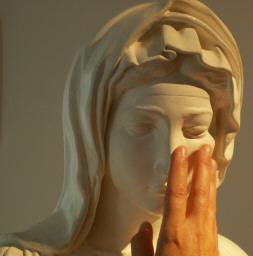Trace your fingers around the curly locks on Michelangelo's David or throw your arms around the Venus De Milo: what could get you tossed out of some museums is just the beginning of a trip to the State Tactile Museum Omero in Ancona.
The largest ''touch'' museum in the world, the Museo Omero was also one of the first, founded in 1993 by a pair of seeing-impaired art lovers, Aldo Grassini and Daniela Bottegoni.
The museum obtained state sponsorship six years later and went on to expand its collection to over 150 pieces including scale models and replicas of some of the world's best loved masterpieces, all of them meant for touching.
''No other museum offers the seeing impaired such a wide panorama of great artworks,'' said museum director Roberto Farroni, who likened the museum to a ''three-dimensional encyclopedia of art.''
Sculpture takes centre stage with works spanning two and a half millennia of art history from the ancient Greeks to modern times.
Life-sized copies of the Artemision Bronze - an ancient Greek sculpture also known as the God from the Sea - and the Uffizi Wrestlers - an ancient Roman marble sculpture after a lost Greek original - give visitors a sense of the classic grace which so inspired the masters of the Renaissance.
An assortment of busts puts at visitors' fingertips such illustrious faces as the Jewish prophet Habakkuk and Giuliano de' Medici, not to mention the museum's namesake, the blind poet Homer.
A plaster bust of David stands almost a meter high at the center of a collection of works by Michelangelo, next to a fiberglass reproduction of the Pieta', which strikes visitors to the Omero much the same way the original does in St Peter's Basilica.
''Touching the Pieta' for the first time was an indescribably moving experience,'' recalled Mirko Montechianni, who first visited the museum while preparing for a university art exam and now works there organizing seminars and cultural exchanges.
''As soon as I put my fingers on it, I realized what it meant. I felt the Madonna's face and I felt pity.'' said Montechianni.
''Before, I was able to tell the difference between an Ionic and a Corinthian capital - but coming to the Omero opened up a new world for me''.
''We also attract a lot of groups from abroad,'' he said, noting the recent visit of a mixed group from Spain, France, Slovenia, Bulgaria and Estonia.
In addition to copies of legendary artworks, the museum boasts a large section of original pieces from contemporary sculptors.
An assortment of architectural models including the Parthenon, the Pantheon and St Peter's gives visitors a chance to feel the designs and decorations which have made them famous throughout history.
During their visit to the museum, seeing-impaired visitors are given a headset and a specially designed walking stick that guides them from one exhibit to the next.
As they approach a new exhibit, a recording on the headset starts automatically to explain the work of art and help them feel their way around it.
''All of our visitors are completely independent,'' said Farroni, stressing however that most visitors prefer a human guide.
OMERO HAS SERVED AS MODEL FOR MUSEUMS AROUND THE WORLD.
''The Museo Omero isn't just a museum for the blind,'' said Montechianni. ''It's a museum for experiencing art through touch. People who can see have a lot to learn here as well.''
Visitors without seeing disabilities can request to be blindfolded and led around the museum by a guide in order to experience the exhibits by touch alone.
The Omero has served as a model for museums around the world in the efforts to bring the visual arts to the seeing impaired.
In 2007, museum staff helped curate a tactile exhibition at the Louvre as part of a show on the Greek sculptor Praxiteles.
In the summer of 2008, co-founder Grassini, went on a lecture tour in Japan where he spoke at the Setagaya Art Museum and National Children's Castle in Tokyo on making art accessible to the blind.
A state run art museum, the Omero still relies heavily on donations and sponsorships.
In 2007, blind pop tenor Andrea Bocelli gave a benefit concert in Ancona which raised over 300,000 euros for the museum and entrepreneur Diego Della Valle of Tod's shoes has been an official sponsor since 2003.
Della Valle has offered to underwrite a new addition to the museum devoted to Formula One racing.
Eventual exhibits would include scale models of care frames and engines in addition to a real chassis for visitors to sit in.
Next year, the Omero is scheduled to move into a 2.400 sqm space in Ancona's 18th century Mole Vanvitelliana, which will almost triple its floor space although cuts in government funding have delayed plans to fill the space with new exhibits.
The museum is not alone in Italy among efforts to broaden art's tactile appeal.
In 2006, an exhibition in Bergamo featuring works by modern sculptor Giacomo Manzu' invited visitors to explore the works on show while wearing a blindfold.
The same year, Florence hosted the world's first ever photography exhibition for the blind by rendering the images in base relief.









